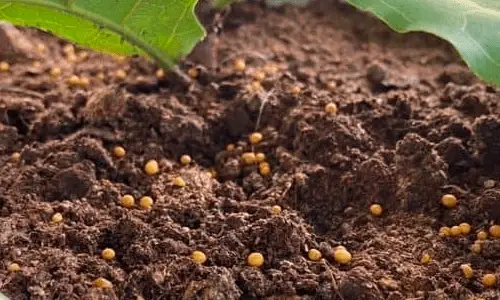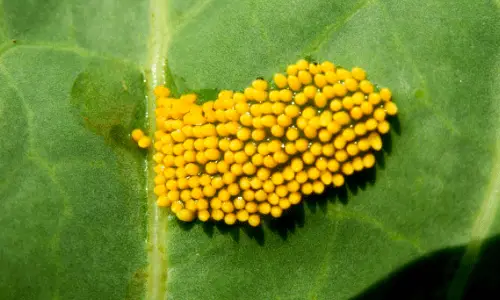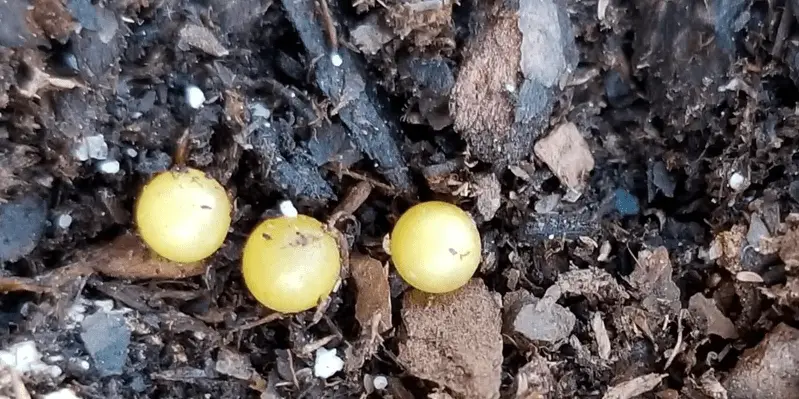The soil in our potted plants should be a healthy, brown, well-draining, and nutrient-rich environment for our plants. However, what if we find small, yellow balls in our soil? Does this mean that something is wrong?
In this blog post, I let you know what those yellow balls might be, and whether or not they’re a cause for concern. Let’s jump right in!
What Are The Yellow Balls in Soil?
It’s likely that the yellow balls in your soil are Osmocote balls. These are small, round, yellow balls made of a slow-release fertilizer. Osmocote is a brand name, but there are other brands that make similar products.
This type of fertilizer is meant to be mixed into the soil before planting. The balls will slowly break down over time, releasing nutrients into the soil for your plants.
However, if the yellow balls appeared suddenly, or if you didn’t add them to the soil yourself, then they might be eggs from a pest. The most common pest that leaves yellow eggs is the beetle.
So, how do you tell the two apart? Which is an egg and which is Osmocote? Well, eggs tend to be smaller and more uniform in size. Osmocote balls, on the other hand, are larger and have a rougher texture. Plus, eggs will be grouped together in a tight cluster, while Osmocote balls will be more spread out.

How Did The Yellow Balls Get There?
If you didn’t add the fertilizer balls to the soil yourself, then it’s likely that they were mixed in with the potting mix when you bought your plant. This is not uncommon, and there’s no need to worry.
You see, the plants in nurseries sit on the shelf for months, so the staff needs a way to keep them healthy and nourished. They do this by adding slow-release fertilizer to the potting mix before putting the plants on display.
When you buy a potted plant, some of the fertilizer balls will come with it. This is not a problem, and you can simply leave them in the soil. They will eventually break down and release nutrients into the soil for your plant.
If you think the yellow balls might be beetle eggs, then it’s possible that a pest landed on your plant and laid its eggs there. If this is the case, you’ll need to take action to get rid of the pests before they hatch.
What is Osmocote?
Osmocote is a brand of slow-release fertilizer that comes in the form of small, round balls. These balls are meant to be mixed into the soil before planting, and they will slowly break down over time, releasing nutrients into the soil for your plants. Osmocote is a great way to ensure that your plants get the nutrients they need without having to fertilize them every week.
However, some of you may not want to use Osmocote in your soil. If this is the case, you can simply remove the fertilizer balls from the soil and dispose of them. Your plants will still be healthy without them.
I’ve removed them myself before, as I prefer to use natural fertilizers like fish emulsion. This is a fertilizer made from fish waste products, and it’s a great way to add nutrients to your soil without using chemicals.
How to Remove Yellow Eggs from Soil?
If you think the yellow balls in your soil are beetle eggs, then you’ll need to take action to get rid of the pests before they hatch. The best way to do this is to remove the eggs from the soil and dispose of them far away from your plants.

To remove the eggs, simply use a spoon or your fingers to scoop them out of the soil. You can then dispose of them in a plastic bag or container. Make sure to wash your hands afterward, as you don’t want to spread the pests to other areas of your garden.
Once you’ve removed the eggs, it’s important to take steps to prevent the pests from returning. This might include using insecticides or traps. Neem oil is a great natural option that disrupts the lifecycle of any pests that come into contact with it.
Conclusion
So, that’s everything you need to know about yellow balls in soil. If you find them in your garden, don’t panic! They’re most likely Osmocote fertilizer balls that are there to help your plants grow.
However, if you think they might be beetle eggs, then take action to remove them from your soil before the pests hatch. It’s also important to remember that pests are inside eggs, so the way you remove them from your garden is very important. You don’t want to accidentally spread the pests to other areas of your yard. Thanks for reading! I hope this was helpful.
Do you have any questions about yellow balls in soil? Leave a comment below and I’ll do my best to answer them. Happy gardening!
Tim is an avid gardener from the UK. He was the founder of PlantCarer.com from 2021 to Sep 2023. He sold PlantCarer.com to Aaron. He has since started his own business called Seed To Supper, which provides new gardeners all the materials you need in a box (pots, seeds, compost and instructions) to grow your own delicious and nutritious vegetables and herbs from start to finish – no garden required.

